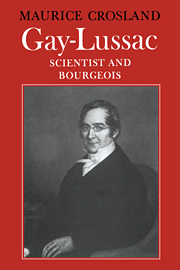Book contents
- Frontmatter
- Contents
- Preface
- Chronological table
- List of abbreviations
- 1 A young provincial in Paris
- 2 The apprentice of Arcueil
- 3 Personal influences and the search for laws
- 4 Collaboration and rivalry
- 5 The volumetric approach
- 6 Scientific research
- 7 Professor, Academician and editor
- 8 A scientist in the service of government and industry
- 9 A new technique and the dissemination of technical information
- 10 Scientist and bourgeois in the political arena
- 11 The legacy
- Appendix: select correspondence
- Notes
- Select bibliography
- Name index
- Subject index
9 - A new technique and the dissemination of technical information
Published online by Cambridge University Press: 03 November 2009
- Frontmatter
- Contents
- Preface
- Chronological table
- List of abbreviations
- 1 A young provincial in Paris
- 2 The apprentice of Arcueil
- 3 Personal influences and the search for laws
- 4 Collaboration and rivalry
- 5 The volumetric approach
- 6 Scientific research
- 7 Professor, Academician and editor
- 8 A scientist in the service of government and industry
- 9 A new technique and the dissemination of technical information
- 10 Scientist and bourgeois in the political arena
- 11 The legacy
- Appendix: select correspondence
- Notes
- Select bibliography
- Name index
- Subject index
Summary
‘Let us therefore march forward and not hesitate to be the first to give the example of a useful reform’
Gay-LussacWe have considered Gay-Lussac's various links with commerce and industry but it is now time to look at general principles. Although Gay-Lussac was capable of applying most aspects of physics and chemistry to practical problems, there was one technique which he made peculiarly his own – that of volumetric analysis. The estimation of purity of solids and liquids was a general requirement of commerce and industry and Gay-Lussac developed a primitive idea of Berthollet's generation along the path towards a sophisticated modern method of general application.
In science new ideas are canvassed in scientific periodicals and sometimes in books but in the field of technology it is not so obvious how communication is to be established between the scientist who devises new methods and the technician or artisan who is to apply them. In the second half of this chapter we shall consider the dissemination of technical information by means of technical booklets or Instructions, a medium to which Gay-Lussac made several major contributions.
Volumetric analysis
Gay-Lussac's contribution to volumetric analysis may be regarded as typical of the chemist, for this new approach to chemistry, although firmly based on theory, was important for its practical applications. It was above all an embodiment of his volumetric approach to nature.
- Type
- Chapter
- Information
- Gay-LussacScientist and Bourgeois, pp. 205 - 225Publisher: Cambridge University PressPrint publication year: 1978
- 1
- Cited by



